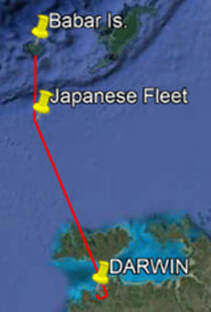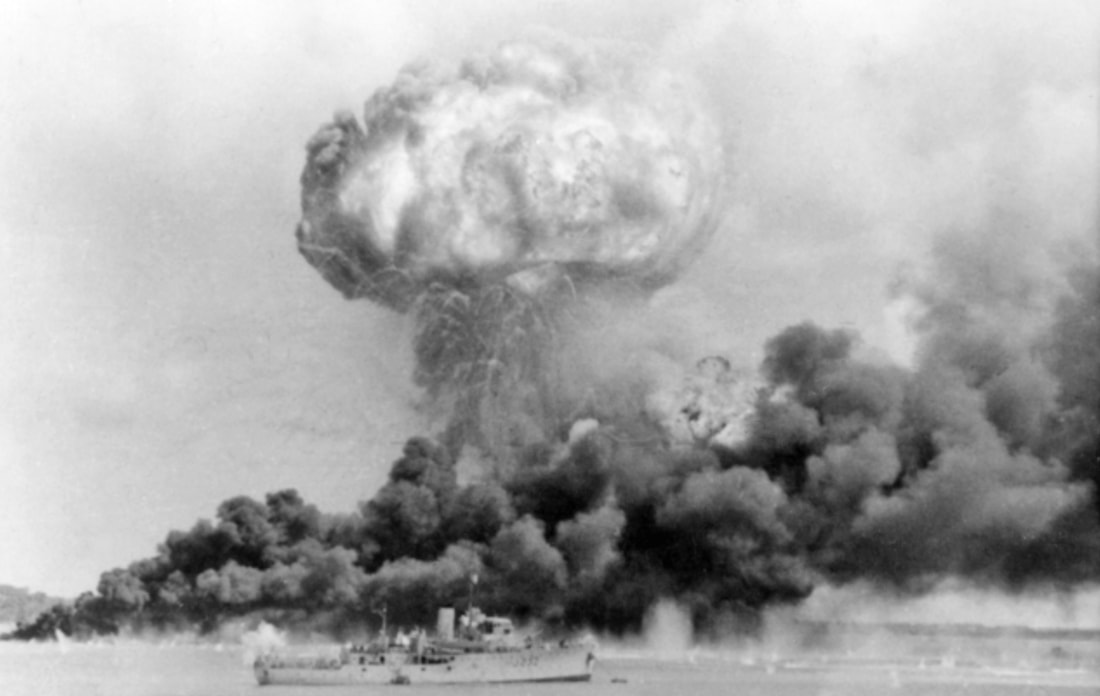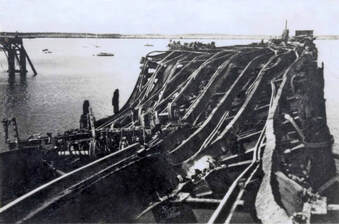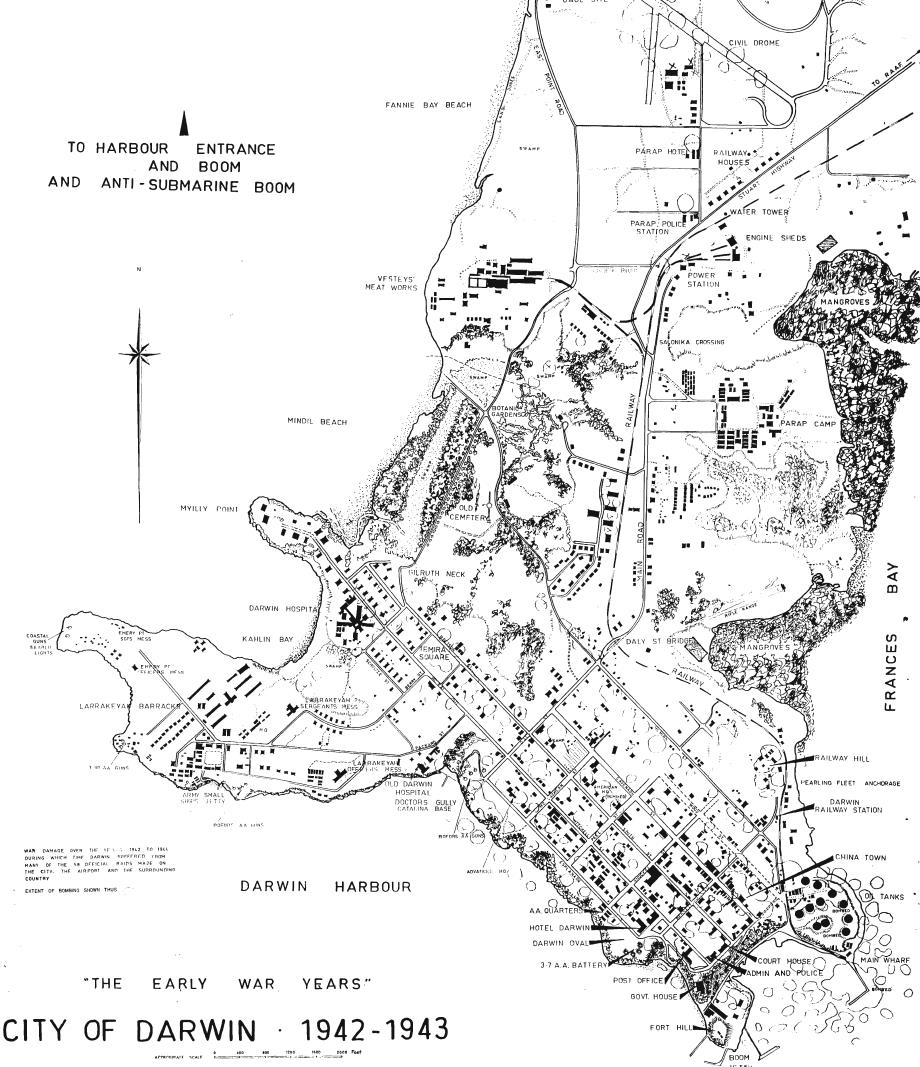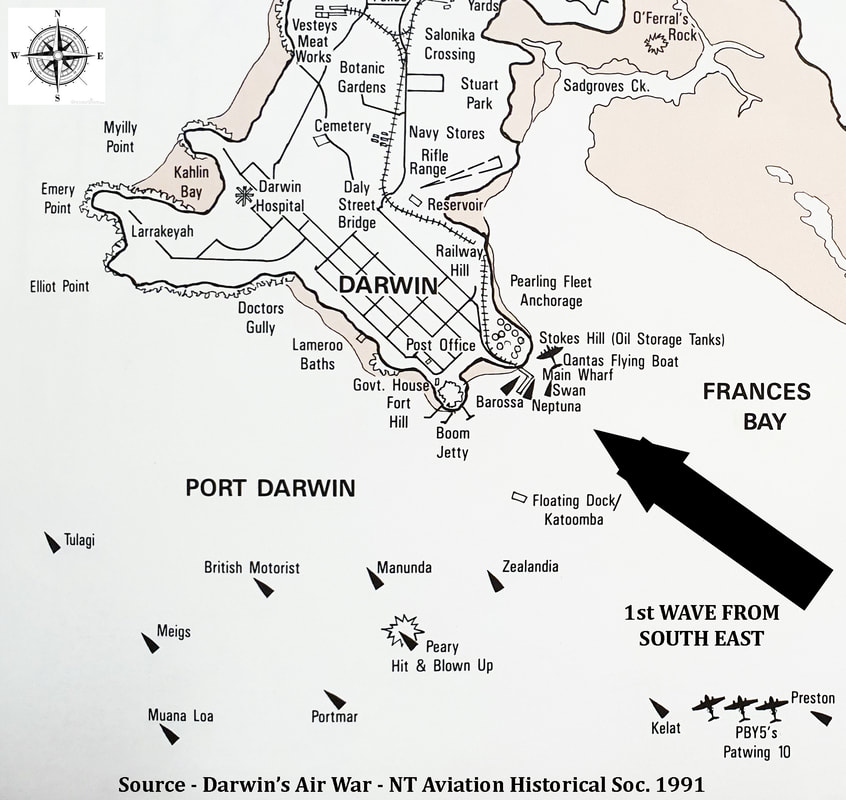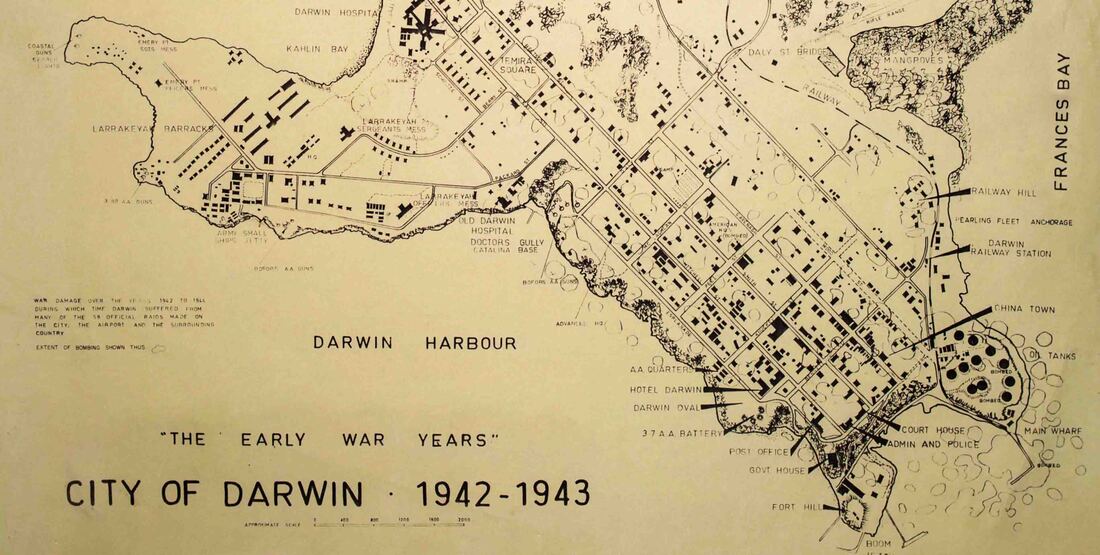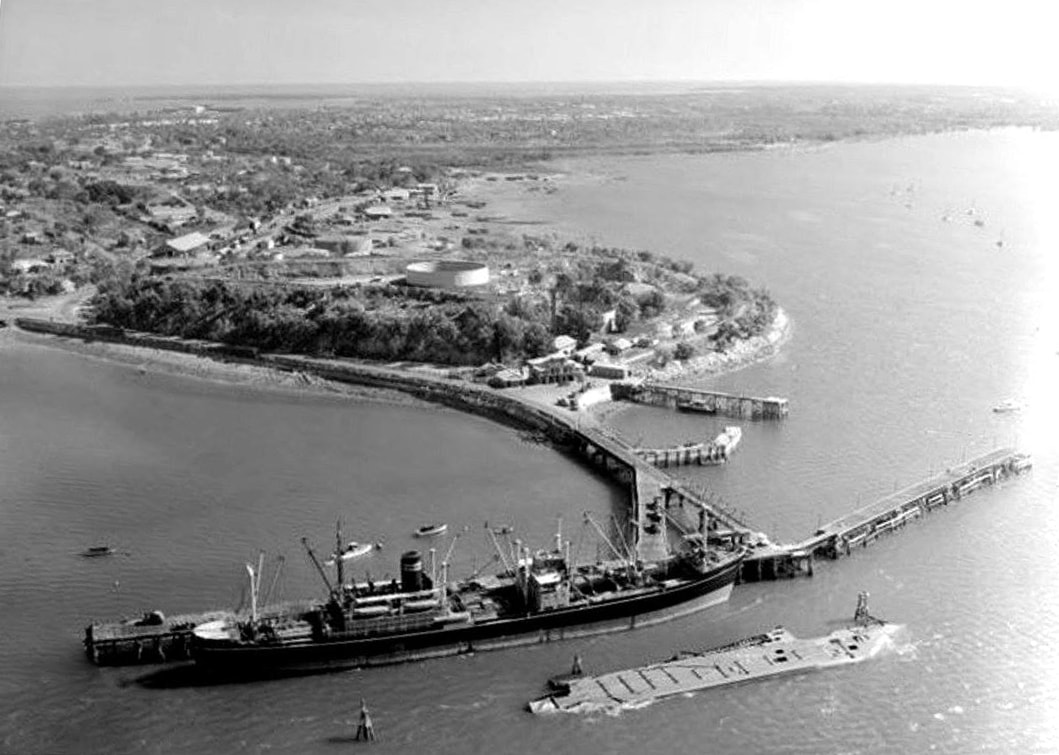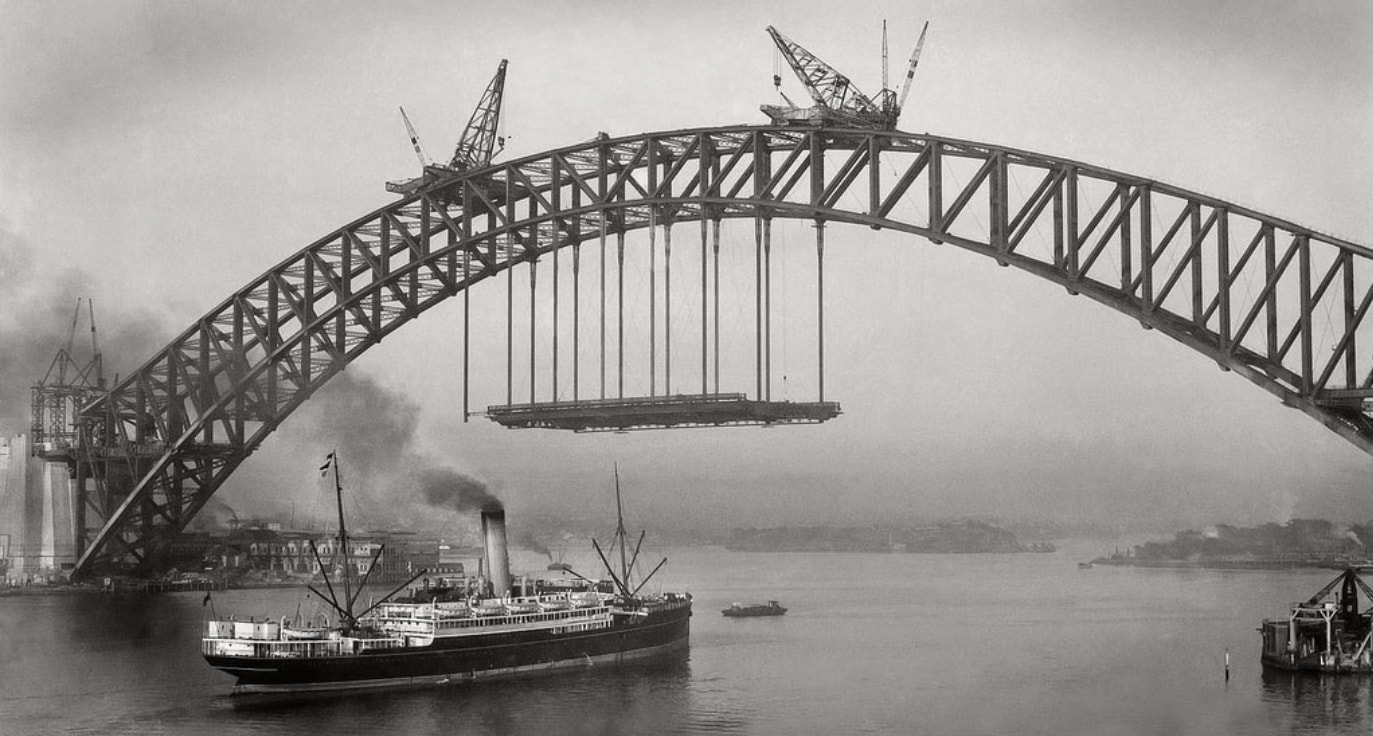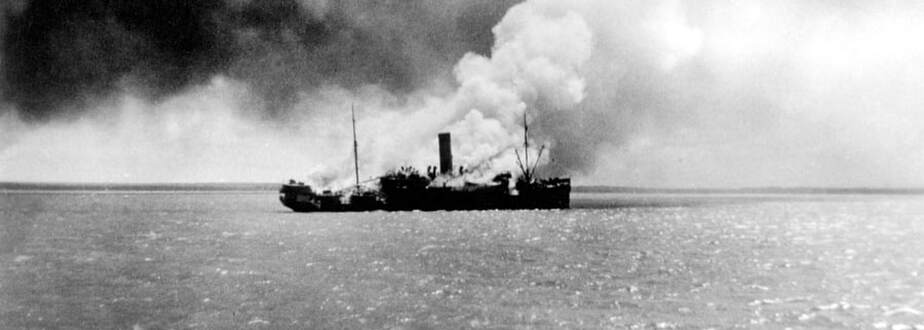BOMBING OF DARWIN
This page offers a summary of events, a timeline and background information. There are few accurate statistics so that a range is given where useful & the estimate of the Australian War Memorial is preferred.
Summary of Thursday 19th February 1942
“On 19 February 1942 Darwin itself was bombed. Japanese fighters and bombers attacked the port and shipping in the harbour twice during the day, killing 252 Allied service personnel and civilians”. Australian War Memorial
“The Japanese air raids on Darwin on 19 February involved, collectively, over 260 enemy aircraft.” Australian War Memorial
The 64th, and last, air raid on Darwin occurred on 12 November 1943. In total there were 97 air attacks on northern Australia and enemy air reconnaissance over the region continued through much of 1944.” Australian War Memorial
“The Japanese air raids on Darwin on 19 February involved, collectively, over 260 enemy aircraft.” Australian War Memorial
The 64th, and last, air raid on Darwin occurred on 12 November 1943. In total there were 97 air attacks on northern Australia and enemy air reconnaissance over the region continued through much of 1944.” Australian War Memorial
Background
|
10-Sep-1941 1st USAF aircraft staged through Darwin, en route Philippines, to avoid Japanese Mandated areas - The South Pacific Air Ferry Route
1-Dec-41 Pearl Harbor attacked by the same Japanese carrier fleet 20-Jan-1942 Japanese Submarine I-124 sunk off Darwin by HMAS Deloraine – south of Bathurst Is. 79 crew aboard - 280ft x 25ft wide (85x7.5 m) 15-Feb-42 Fall of Singapore – 90,000 British, Australian & Indian garrison surrendered 16-Feb-42 Fall of Sumatra 18-Feb-42 Japanese fleet 4 Carriers + escorts – 80 miles South Babar Is. – 230 miles NNW of Darwin. Carriers Akagi – Kaga – Hiryu & Soryu Aircraft 'Kate' Nakajima B5N Type 97-3 Carrier-borne Torpedo Bomber - as a light level bomber 'Val' Aichi D3A Type 99 Carrier-borne Dive Bomber 'Zero' Mitsubishi A6M Navy Type 'O' - fighter |
BoD Day 19th February 1942
0845 Carriers launched 188 aircraft - 81 Kate light bombers - 71 Val dive bombers & 36 Zero fighters – no torpedoes
One USAF C47 Skytrain aircraft strafed on the ground at Bathurst Island mission strip.
TOM Moorer USN Catalina downed by Petty Officer Yoshikazu Nagahama flying escort in a Zero fighter. He arrived over Darwin alone & ahead of the strike force, which had flown down Apsley Strait & was making a turn east of Darwin – in order to attack from the south east as all the targets from the Stokes Hill oil tanks to the Hospital - including the ships at anchor - were in a narrow SE to NW corridor. He engaged five US Army Air Force P-40 Kittyhawk fighters and single-handedly shot down four of them. (Tagaya 2011 – Hata, Izawa & Shores 2011)
One USAF C47 Skytrain aircraft strafed on the ground at Bathurst Island mission strip.
TOM Moorer USN Catalina downed by Petty Officer Yoshikazu Nagahama flying escort in a Zero fighter. He arrived over Darwin alone & ahead of the strike force, which had flown down Apsley Strait & was making a turn east of Darwin – in order to attack from the south east as all the targets from the Stokes Hill oil tanks to the Hospital - including the ships at anchor - were in a narrow SE to NW corridor. He engaged five US Army Air Force P-40 Kittyhawk fighters and single-handedly shot down four of them. (Tagaya 2011 – Hata, Izawa & Shores 2011)
0935 Father McGrath radioed warning message from Bathurst Is. Sacred Heart Mission
0937 Message relayed to RAAF by AWA Postal Radio Station Darwin – ignored – thought it was returning P-40s - no alarm sounded
0937 Message relayed to RAAF by AWA Postal Radio Station Darwin – ignored – thought it was returning P-40s - no alarm sounded
1st Wave
Objective - to destroy capacity of Darwin to resupply American ships and aircraft.
|
0956 Nine ‘V’ formations each of 9 bombers (81 bombers) = total 188 (71 Val dive bombers – 81 Kate torpedo bombers – 36 Zero fighters)
0958 Bombs hit wharf area – Fuel tanks & HMAS Gunbar attacked by Zeros 1000 Air raid sirens sounded 1001 Post & Telegraph Office destroyed killing 10 people – possibly some overshoot of bombs but itself a large important target. 1005 Hospital hit - new facility above Kahlin Beach 1005 -1010 Ships hit - British Motorist – Mauna Loa & Meigs 1030 End ship & port facilities strike |
Sunk - 3 warships & 6 merchantmen – 10 damaged. USS Peary, HMAS Mavie, USAT Meigs, MV Neptuna , SS Zealandia, SS Mauna Loa, MV British Motorist – oiler Karalee & Kelat sank later.
|
21 'wharfies' killed - Stokes Hill Wharf all but destroyed - fuel delivery & supply lines cut - railway track cut.
9 of 10 P40 Kittyhawks lost – Lt Robert Oestreicher shot down 1 Aichi & damaged another. Heavy damage to base & civil airfield – army barrack, Stokes Hill oil storage & Post Office/BAT buildings Japanese Losses c5 aircraft & 3 crew – 34 had battle damage of small arms fire – 2 killed in dive bomber crash near Darwin – 1 Zero pilot prisoner Melville Is. |
2nd Wave
Objective - To deny Darwin airfields to USAF bombers bound for the Philippines & remove any impediment to the invasion of Timor on 20-2-42
1158 Sirens sound
54 land-based medium bombers – 27 Nell x Ambon & 27 Betty x Kendari in Celebes - pincer movement over airbase 18000ft – approach from SW & NE at same time – turned & made second run
1200 Enemy aircraft arrived
Half attack RAAF Base from SW – others from SE at 18000ft – dropped bombs simultaneously – turned away & made second run. Defective altitude fuses in heavy AA ammunition meant no planes shot down.
1220 Enemy aircraft depart
RAAF - 6 Hudsons destroyed + 1 x Hudson & 1 x Wirraway badly damaged. USAF - 2 x P40 & a B24 Liberator destroyed. 6 RAAF personnel killed. Lewis & Ingam 30 planes destroyed
PM Dive bombers launched x carriers
Don Isidro sunk 1st – one hour later Florence D sunk – one Moorer’s crew killed in Florence D – rest washed up Bathurst Is. spotted by locals – McGrath picked them up & later delivered to Darwin.
Rumours of a Japanese landing and inadequate command resulted in a stamped that became known as the Adelaide River Stakes - reputedly won by a garbage truck.
The day after the attack the Prime Minister quoted on the front pages of most newspapers: "Damage to property was considerable", he said, "but reports so far to hand do not give precise particulars about the loss of life." "The Government regards the attacks as most grave, and makes it quite clear that a severe blow has been struck on Australian soil."[124] Argus Mlbn 20 Feb. - Courier Mail “Blitz of most ferocious kind” and “Worse than London Blitz”
Most people in Australia asked - How many ships were sunk? - How many people were killed? And where is Darwin exactly?
Conversely, Midget submarines sinking an unseaworthy ferry in Sydney Harbour, 3 months later, causes widespread panic.
278 RAAF cited as ‘deserters’ but none charged as orders were confused – mass looting – Adelaide River Stakes won by a garbage truck – rout stopped at Birdum & long march north to Nagasaki began. 'Looting' included linen and kerosene refrigerators for the hospital.
54 land-based medium bombers – 27 Nell x Ambon & 27 Betty x Kendari in Celebes - pincer movement over airbase 18000ft – approach from SW & NE at same time – turned & made second run
1200 Enemy aircraft arrived
Half attack RAAF Base from SW – others from SE at 18000ft – dropped bombs simultaneously – turned away & made second run. Defective altitude fuses in heavy AA ammunition meant no planes shot down.
1220 Enemy aircraft depart
RAAF - 6 Hudsons destroyed + 1 x Hudson & 1 x Wirraway badly damaged. USAF - 2 x P40 & a B24 Liberator destroyed. 6 RAAF personnel killed. Lewis & Ingam 30 planes destroyed
PM Dive bombers launched x carriers
Don Isidro sunk 1st – one hour later Florence D sunk – one Moorer’s crew killed in Florence D – rest washed up Bathurst Is. spotted by locals – McGrath picked them up & later delivered to Darwin.
Rumours of a Japanese landing and inadequate command resulted in a stamped that became known as the Adelaide River Stakes - reputedly won by a garbage truck.
The day after the attack the Prime Minister quoted on the front pages of most newspapers: "Damage to property was considerable", he said, "but reports so far to hand do not give precise particulars about the loss of life." "The Government regards the attacks as most grave, and makes it quite clear that a severe blow has been struck on Australian soil."[124] Argus Mlbn 20 Feb. - Courier Mail “Blitz of most ferocious kind” and “Worse than London Blitz”
Most people in Australia asked - How many ships were sunk? - How many people were killed? And where is Darwin exactly?
Conversely, Midget submarines sinking an unseaworthy ferry in Sydney Harbour, 3 months later, causes widespread panic.
278 RAAF cited as ‘deserters’ but none charged as orders were confused – mass looting – Adelaide River Stakes won by a garbage truck – rout stopped at Birdum & long march north to Nagasaki began. 'Looting' included linen and kerosene refrigerators for the hospital.
The Wash Up
25-Feb-42 Joint American, British, Dutch Australian Command dissolved – ABDA COM
27-Feb-42 Battle of the Java Sea – 5 allied warships sunk for 1 Japanese – Japs landed next day & Java fell on 9th March – 20k allies surrendered
27/28-Feb-42 "During the last two days of February {1942}, Japanese air and naval forces cleared the seas of Allied ships. In the battles of the Java Sea - the USS Langley, carrying forty P-40s {Kittyhawks} to Javanese airfields, went down, and the crew of the Sea Witch threw overboard twenty-seven more P-40s to keep them out of enemy hands. Elsewhere, in waters off Java, five Allied cruisers and six Allied destroyers fell victim to Japanese air and sea power, and the remnants of the American-British-Dutch-Australian navy scattered to Ceylon and Australia." (U.S. Army Center of Military History by Charles R. Anderson)
11-Mar-42 General MacArthur escapes Philippines – 70,000 military personnel left behind to surrender – 'Worst defeat in US history'
After ABDACOM – MacArthur given command of SW Pacific & Nimitz commanded Pacific Ocean areas.
22-Mar-42 Qantas Short Flying Boat Corinthian hit debris at 1am & sank 2nm of Dr’s Gully – 2 killed – plane still missing.
8-May-42 Battle of the Coral Sea – Japanese withdraw blooded
31-May-1942 Japanese midget submarines attack Sydney Harbour – sink one unseaworthy ferry – major panic ensued.
5-June-42 Battle of Midway – Japanese navy soundly defeated by the carriers they failed to sink at Pearl Harbor - just 6 months before.
12-11-1943 64th & last air raid on Darwin - total 97 air attacks on northern Australia reconnaissance continued through much of 1944 - AWM
1956 USS Peary wreck found by HMAS Quadrant – no bullion sadly but deemed by Harbourmaster to be in quarantine area - a hazard to shipping.
1960 Ships inc. USS Peary (war grave) salvaged by Fujita of Japan after inspection by RAN divers. Guns from East Point & railway trains from Katherine included in the scramble to sell anything metal.
27-Feb-42 Battle of the Java Sea – 5 allied warships sunk for 1 Japanese – Japs landed next day & Java fell on 9th March – 20k allies surrendered
27/28-Feb-42 "During the last two days of February {1942}, Japanese air and naval forces cleared the seas of Allied ships. In the battles of the Java Sea - the USS Langley, carrying forty P-40s {Kittyhawks} to Javanese airfields, went down, and the crew of the Sea Witch threw overboard twenty-seven more P-40s to keep them out of enemy hands. Elsewhere, in waters off Java, five Allied cruisers and six Allied destroyers fell victim to Japanese air and sea power, and the remnants of the American-British-Dutch-Australian navy scattered to Ceylon and Australia." (U.S. Army Center of Military History by Charles R. Anderson)
11-Mar-42 General MacArthur escapes Philippines – 70,000 military personnel left behind to surrender – 'Worst defeat in US history'
After ABDACOM – MacArthur given command of SW Pacific & Nimitz commanded Pacific Ocean areas.
22-Mar-42 Qantas Short Flying Boat Corinthian hit debris at 1am & sank 2nm of Dr’s Gully – 2 killed – plane still missing.
8-May-42 Battle of the Coral Sea – Japanese withdraw blooded
31-May-1942 Japanese midget submarines attack Sydney Harbour – sink one unseaworthy ferry – major panic ensued.
5-June-42 Battle of Midway – Japanese navy soundly defeated by the carriers they failed to sink at Pearl Harbor - just 6 months before.
12-11-1943 64th & last air raid on Darwin - total 97 air attacks on northern Australia reconnaissance continued through much of 1944 - AWM
1956 USS Peary wreck found by HMAS Quadrant – no bullion sadly but deemed by Harbourmaster to be in quarantine area - a hazard to shipping.
1960 Ships inc. USS Peary (war grave) salvaged by Fujita of Japan after inspection by RAN divers. Guns from East Point & railway trains from Katherine included in the scramble to sell anything metal.
Background Notes
Oil Tunnels
The air raids of early 1942 almost totally destroyed the above ground oil storage tanks which had been constructed around Stokes Hill. Part of the Allied response was to commission eight underground oil storage tanks which would be safe from bombing. Work began in 1943 but only five tunnels were finished when the war ended. They were never used for bulk oil storage - like the East Point guns that never fired a shot in anger.
The air raids of early 1942 almost totally destroyed the above ground oil storage tanks which had been constructed around Stokes Hill. Part of the Allied response was to commission eight underground oil storage tanks which would be safe from bombing. Work began in 1943 but only five tunnels were finished when the war ended. They were never used for bulk oil storage - like the East Point guns that never fired a shot in anger.
AA Battery
8- Dec 1940 – 26 Feb 1943 the old cricket ground was the location of the 14 Heavy Anti-aircraft Battery - four 3.7 inch guns.
8- Dec 1940 – 26 Feb 1943 the old cricket ground was the location of the 14 Heavy Anti-aircraft Battery - four 3.7 inch guns.
Steam Pump House
Built 1927 pumped heavy bunker oil from ships into storage tanks and back again. 1st shipment of Borneo Oil was 8000 tons in March 1928. At the end of the war they were progressively replaced by electric pumps. The pumps were last used in 1963 with the steam pumps were disconnected in 1989 but remain serviceable today.
Built 1927 pumped heavy bunker oil from ships into storage tanks and back again. 1st shipment of Borneo Oil was 8000 tons in March 1928. At the end of the war they were progressively replaced by electric pumps. The pumps were last used in 1963 with the steam pumps were disconnected in 1989 but remain serviceable today.
Kelat Coal
Navy ships transitioned from oil but some still burned coal in 1942 and it was stored in the Kelat - an 1881 clipper hulk – sank at her moorings. The capacity of HMAS Patricia Cam to fish for coal with a mechanical grab was a significant advantage - she would be commanded by Lt. Meldrum who served with distinction in command of HMAS Deloraine during the BoD.
Navy ships transitioned from oil but some still burned coal in 1942 and it was stored in the Kelat - an 1881 clipper hulk – sank at her moorings. The capacity of HMAS Patricia Cam to fish for coal with a mechanical grab was a significant advantage - she would be commanded by Lt. Meldrum who served with distinction in command of HMAS Deloraine during the BoD.
Oil tank Farm
In 1924 the Australian Government committed itself to building oil storage facilities in Darwin to replace coal bunkering at Thursday Island. To secure the waters north of Australia, Darwin was to be developed as a naval base. Eleven storage tanks were actually built by 1942. The need to protect them against enemy attack was the catalyst for a dramatic escalation in Darwin’s defences in the 1930’s. However, because of an inadequate appreciation of the risk of air attack, the protection of the tanks against aerial bombing was totally inadequate. During February, March and June 1942 Japanese bombing almost totally destroyed Darwin’s oil storage capacity during a series of savage air raids. Tank (No.6) was bombed during an early air raid however the fires were put out and some of the oil salvaged. Part of the concrete shell of the tank has survived to remind us of those dramatic photographs of huge columns of dense black smoke rising above Darwin as the oil stored in the tanks burned after bombing raids. – Concrete shells were added so the impression is preserved in the concrete that has been preserved by NT Heritage Branch. The tanks along the esplanade & 2 at Doctors Gully were connected by a pipe that partially survives today.
In 1924 the Australian Government committed itself to building oil storage facilities in Darwin to replace coal bunkering at Thursday Island. To secure the waters north of Australia, Darwin was to be developed as a naval base. Eleven storage tanks were actually built by 1942. The need to protect them against enemy attack was the catalyst for a dramatic escalation in Darwin’s defences in the 1930’s. However, because of an inadequate appreciation of the risk of air attack, the protection of the tanks against aerial bombing was totally inadequate. During February, March and June 1942 Japanese bombing almost totally destroyed Darwin’s oil storage capacity during a series of savage air raids. Tank (No.6) was bombed during an early air raid however the fires were put out and some of the oil salvaged. Part of the concrete shell of the tank has survived to remind us of those dramatic photographs of huge columns of dense black smoke rising above Darwin as the oil stored in the tanks burned after bombing raids. – Concrete shells were added so the impression is preserved in the concrete that has been preserved by NT Heritage Branch. The tanks along the esplanade & 2 at Doctors Gully were connected by a pipe that partially survives today.
Resources
"DARWIN BOMBED" THE UNIT HISTORY OF 14 HEAVY ANTI-AIRCRAFT BATTERY by Jack Mulholland
Carrier Attack Darwin 1942 - Lewis & Ingman
The Shadow's Edge - Powell
Australia's Pearl Harbour - Lockwood
An Awkward Truth - Grose
Darwin's Air War - NT Aviation Historical Society
Carrier Attack Darwin 1942 - Lewis & Ingman
The Shadow's Edge - Powell
Australia's Pearl Harbour - Lockwood
An Awkward Truth - Grose
Darwin's Air War - NT Aviation Historical Society
